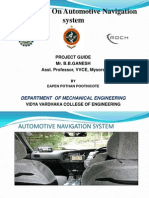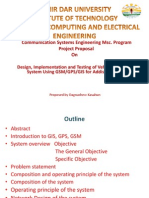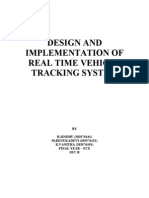Vehicle Tracking
Vehicle Tracking
Uploaded by
suneelkluCopyright:
Available Formats
Vehicle Tracking
Vehicle Tracking
Uploaded by
suneelkluCopyright
Available Formats
Share this document
Did you find this document useful?
Is this content inappropriate?
Copyright:
Available Formats
Vehicle Tracking
Vehicle Tracking
Uploaded by
suneelkluCopyright:
Available Formats
NCSCV- 10NATIONAL CONFERENCE ON SIGNAL PROCESSING COMMUNICATIONS& VLSI DESIGN
VEHICLE TRACKING SYSTEM USING ARM MICROCONTROLLER BASED ON GPS
K V L Bhavani1, B.T.P.Madhav2 P.Praveen Kumar3, K.Ravikumar4 P.Poorna Priya5, Pranob K Charles6
1,2,3,4,5 6
Asst Professor ,K L UNIVERSITY Assoc Professor, K L UNIVERISTY
kbhavani29@gmail.com
ABSTRACT: Vehicle Tracking System is a method used to track the location of the any vehicle around the globe. It is based on the GPS (Global Positioning System). Vehicle Tracking System has become a necessity for business owners around the globe trying to manage a fleet. This is used to locate the cars, motor bikes or any vehicles. The focus of a GPS based vehicle Tracking System is to make use of the knowledge of vehicles location and apply its network attributes such as the stops, timing, available alternative emergency routes and other such constraints in order to optimize opportunities for productivity and cost reduction. Now, that GPS based solutions are available and affordable, its benefits are no longer limited to long-haul trucking companies but also to a host of other services. This is used for company fleet management. GPS Module receives the latitude and longitude positions of the vehicle. These values are given to the ARM Microcontroller, which formats the GPS String in the form such that it is useful in the base station for further processing. Formatted GPS string will be send to the base station using GSM Modem in the form of SMS. In the base station received string will be shown on Data grid view of front-end software. In addition to showing current position details of vehicle in Data grid view, fleet management features .i.e. creating database of drivers and vehicles, Administrating of drivers and vehicles, Maintenance details of vehicles with Reminders are also implemented. Keywords: Global System for Mobile Communication, Inter Integrated Circuit, Universal Asynchronous Receiver Transmitter, General Purpose Input/Output ports, Vectored Interrupt Controller , Common language runtime, Real View Compilation Tools
bikes or any vehicles. The focus of a GPS based vehicle Tracking System is to make use of the knowledge of vehicles location and apply its network attributes such as the stops, timing, available alternative emergency routes and other such constraints in order to optimize opportunities for productivity and cost reduction. Now, that GPS based solutions are available and affordable, its benefits are no longer limited to long-haul trucking companies but also to a host of other services. This is used for company fleet management. One of the fast-growing GPS applications is vehicle tracking. GPS-equipped fleet vehicles, public transportation systems, delivery trucks, and courier services use receivers to monitor their locations at all times. Automatic Vehicle Location (AVL) is a technologically advanced method of remote vehicle tracking and monitoring using GPS. Each vehicle is equipped with a module that receives signals from a series of satellites, and calculates its current geographical location, speed, and heading. This information can be stored for later retrieval or, frequently, transmitted to a central dispatch/control location where it is displayed on a highresolution geographical map. Important factor in GPS is the much accuracy and speed. Global Positioning System (GPS) systems, combined with mobile telephony system (GSM), give you the power to rapidly locate or track any vehicle in your fleet (or, where applicable, other types of movable assets). You have the assurance of knowing where your fleet is, where it has been, and in which direction it is headed. Unlike some past systems, you do not need your own base station infrastructure and you are not limited to a local geographic coverage area. GPS is a satellite navigation system designed to provide instantaneous position, velocity and time information almost anywhere on the globe at any time, and in any weather. It gathers and stores GPS satellite signals, showing the exact location visited by the
I. INTRODUCTION
Vehicle Tracking System is a system used to track the location of the any vehicle around the globe. It is based on the GPS (Global Positioning System). Vehicle TrackingSystem has become a necessity for business owners around the globe trying to manage a fleet. This is used to locate the cars, motor
NCSCV- 10NATIONAL CONFERENCE ON SIGNAL PROCESSING COMMUNICATIONS& VLSI DESIGN
vehicle, how long it was there, speeds en route and the time the vehicle left each location. We can remotely transmit the GPS position using the GSM network and SMS. We can send telemetry data as an SMS text message. This means that assets can be seamlessly and reliably tracked almost anywhere in the world.
o o o
Creating & maintaining details of drivers & vehicles. Administration of fleets & Drivers. Vehicle maintenance
II. ARCHITECTURE
To implement tracking system, tracking unit is needed. In the design of tracking unit GPS Module and GSM Modem and microcontroller and EEPROM. So Microcontroller must have UART and I2C.Baased on these requirements Microcontroller selected is NXP LPC 2148, because it has two On-chip UART and I2C hardware. In addition to that it has SPI, SSP peripherals, which are very much useful for providing the future enhancements to the existing tracking system. A. VTS has three parts a. Vehicle side contains GPS module (LS 23066) GSM modem (Analogic SM01) NXP LPC 2148 EEPROM (AT24C256) LCD Display a) LED Display b) c) b. Base station contains GSM modem Personal Computer f) d) e) Do all initializations of UART, I2C, timer, then include as header files. Clear GPS array, set GPS ClearFlag. Enable UART1, In UART1 ISR check for starting character, set DollerFlag. Check for GPRMC, if OK set RMCFlag. Check for all above flags, and size is less than 70, then copy whole string into array. At last disable the interrupt. Clear GSM array, send AT command to check GSM network. Check for OK in consecutive locations of GSM array in UART0 ISR. Send Base station no using AT+CMGS, and have to send 13. Fig 2. Base Station Side Block diagram
Fig 1. Vehicle Side Block diagram
III. ALGORITHM
c. Front-end software Front-end software is created on c#.net, which will effectively optimize the fleet operations by providing the following features
g)
h)
NCSCV- 10NATIONAL CONFERENCE ON SIGNAL PROCESSING COMMUNICATIONS& VLSI DESIGN
i)
j)
Call GPS function, it will copy all time lat, long, date in GPS array to corresponding arrays. Then call i2c_read function (). Send all messages as required in base station, wait for one minute then repeat the process.
IV. RESULTS
Five tracking units are fabricated, through which captured tracking information i.e. string (GPRMC), added VEHICLE ID, sent to base station using GSM network. Tested for different Routes in Hyderabad.
Fig 5. Showing Vehicle ID, Date, Time, and Lat/long related to Hyd.
V. CONCLUSIONS Five tracking units are fabricated, through which captured tracking information (GPS string), added VEH IDs, sent to base station using GSM network. Tested for different Position details are compared with corresponding values in Google map for routes in Hyderabad. Position details of vehicle displayed on data grid view of front-end software in the Base station.
Fig 3.Tracking unit
For respective routes for verification. Feature of Administration of fleets and drivers are provided as per efficient operation for fleet managers. A feature with maintenance of vehicles is provided in all views for the benefit to fleet management.
REFERENCES
1. M.Ibnkahla, Signal Processing For Mobile Communication Hand Book, CRC Press,pp.1-1 To 1-3, 2004 Wavecom, AT Commands Interface Guide, Version. 001/9.1, Pp.127-128, November 2001.
2.
Fig 4. User interface to download vehicle ID to Tracking unit
You might also like
- SC1001 Huawei SmartCare CEM SOC Solutions Master Slides Technical v2 8 20140616 PDFDocument54 pagesSC1001 Huawei SmartCare CEM SOC Solutions Master Slides Technical v2 8 20140616 PDFThu Hằng Trần100% (1)
- Vehicular TrackingDocument3 pagesVehicular TrackingStu DentNo ratings yet
- 16.design of Vechile Positioning System Based On ARMDocument3 pages16.design of Vechile Positioning System Based On ARMvinay_2211No ratings yet
- Gps Project ReportDocument82 pagesGps Project Reportgsrawat123No ratings yet
- Akash Chaudhary ReportDocument10 pagesAkash Chaudhary ReportAki ChaudharyNo ratings yet
- Real Tie M Gps Gprs Based Vehicle Tracking SystemDocument6 pagesReal Tie M Gps Gprs Based Vehicle Tracking SystemSruthi ReddyNo ratings yet
- Synopsis FINAMLDocument18 pagesSynopsis FINAMLAki ChaudharyNo ratings yet
- Vehicle Tracking System For Commercial VehiclesDocument6 pagesVehicle Tracking System For Commercial VehiclesNIET Journal of Engineering & Technology(NIETJET)No ratings yet
- Engr Ogunkeyede 2Document45 pagesEngr Ogunkeyede 2kodatechNo ratings yet
- Automatic Vehicle LocatorDocument7 pagesAutomatic Vehicle LocatorPravallika RepanaNo ratings yet
- AutomobiletrackingsystemDocument35 pagesAutomobiletrackingsystemNavin H YadavNo ratings yet
- W GPS GPRS GSM Based Mobile Asset TrackingDocument11 pagesW GPS GPRS GSM Based Mobile Asset TrackingMarima SimbarasheNo ratings yet
- Automotive Navigation SystemsDocument15 pagesAutomotive Navigation SystemsVarun GanapathyNo ratings yet
- GPS Based Low Cost Intelligent Vehicle Tracking System (IVTS)Document5 pagesGPS Based Low Cost Intelligent Vehicle Tracking System (IVTS)Kiran KumarNo ratings yet
- Custom CRM System Online Appointment ServiceDocument1 pageCustom CRM System Online Appointment ServiceLuis CortesNo ratings yet
- Research On The Integrity Monitoring of GPS Vehicle SystemDocument4 pagesResearch On The Integrity Monitoring of GPS Vehicle SystemfranzkilaNo ratings yet
- Land Vehicle Tracking System Using Java On Android PlatformDocument7 pagesLand Vehicle Tracking System Using Java On Android PlatformAlexander DeckerNo ratings yet
- What Is Vehicle Tracking?Document3 pagesWhat Is Vehicle Tracking?naanthaanda123No ratings yet
- Iaetsd Vehicle Monitoring and Security SystemDocument3 pagesIaetsd Vehicle Monitoring and Security SystemiaetsdiaetsdNo ratings yet
- Formula Student Racing Championship: Design and Implementation of An Automatic Localization and Trajectory Tracking SystemDocument11 pagesFormula Student Racing Championship: Design and Implementation of An Automatic Localization and Trajectory Tracking Systemfildi95No ratings yet
- A Real Time Driving Evaluation and Vehicle Tracking System Using Radio Frequency ControllerDocument4 pagesA Real Time Driving Evaluation and Vehicle Tracking System Using Radio Frequency ControllerAbdullahNo ratings yet
- Communication Systems Engineering Msc. Program Project Proposal OnDocument21 pagesCommunication Systems Engineering Msc. Program Project Proposal OnDagne SoliyanaNo ratings yet
- Automated Bus Stop Alert For Passengers Using GPS: Vijetha Tummala, S.Akshay Kumar, P.Srinivas, G.SravanDocument2 pagesAutomated Bus Stop Alert For Passengers Using GPS: Vijetha Tummala, S.Akshay Kumar, P.Srinivas, G.SravanerpublicationNo ratings yet
- Design and Implementation of Real Time Vehicle Tracking SystemDocument9 pagesDesign and Implementation of Real Time Vehicle Tracking SystemDivya MuraliNo ratings yet
- Vehicle Tracking System Using Map-Matching Search Algorithm.Document45 pagesVehicle Tracking System Using Map-Matching Search Algorithm.Okunade Oluwafemi100% (2)
- Navigation SystemDocument22 pagesNavigation System19MCE24 Poovendhan VNo ratings yet
- IRC 2022 Proceedings - Com - Draft FOC-140-147Document8 pagesIRC 2022 Proceedings - Com - Draft FOC-140-147haiderNo ratings yet
- IHMSC.2018.10183v TpsDocument4 pagesIHMSC.2018.10183v TpsMd SazzadNo ratings yet
- Multi Tracking System: Sameer Darekar, Atul ChikaneDocument3 pagesMulti Tracking System: Sameer Darekar, Atul ChikaneSameer DarekarNo ratings yet
- Advanced Vehicle ControlDocument108 pagesAdvanced Vehicle ControlRAJASHEKHARNo ratings yet
- IOT Based Real-Time Vehicle Tracking SystemDocument6 pagesIOT Based Real-Time Vehicle Tracking SystemPavan VNo ratings yet
- Research Paper On Vehicle Tracking SystemDocument6 pagesResearch Paper On Vehicle Tracking Systemixevojrif100% (1)
- IOT_Based_Real-Time_Vehicle_Tracking_SystemDocument6 pagesIOT_Based_Real-Time_Vehicle_Tracking_SystemHarsh KumarNo ratings yet
- Vehicle Tracking System Using GPS-GSM Accident Detection and Theft SecurityDocument8 pagesVehicle Tracking System Using GPS-GSM Accident Detection and Theft Securitybrryyyt.29No ratings yet
- Submitted To-Submitted byDocument4 pagesSubmitted To-Submitted bydeepkamal_jaiswalNo ratings yet
- Model - Starting PagesDocument15 pagesModel - Starting PagesVenkatesh ReddyNo ratings yet
- Project: Chapter OneDocument44 pagesProject: Chapter OneAzzam Ayoub100% (1)
- Design and Implementation of A Fleet Management SyDocument8 pagesDesign and Implementation of A Fleet Management Sysami teferiNo ratings yet
- Term Paper On Gps For Vehicle TrackingDocument6 pagesTerm Paper On Gps For Vehicle Trackingea0bvc3s100% (1)
- SharanpreetDocument3 pagesSharanpreetporfy2No ratings yet
- Design and Implementation of A Fleet Management SyDocument8 pagesDesign and Implementation of A Fleet Management SySagar ChouguleNo ratings yet
- Fleet ManagmentDocument11 pagesFleet ManagmentLens NewNo ratings yet
- Vehicle Tracking SystemDocument62 pagesVehicle Tracking SystempandiNo ratings yet
- SSRN Id3884903Document5 pagesSSRN Id3884903HE TRAVEL AND TOURISMNo ratings yet
- Vehicle Tracking System: Project ReportDocument17 pagesVehicle Tracking System: Project ReportMahaveer GodaraNo ratings yet
- GPS and GPRS Based Real Time Vehicle Tracking On Google EarthDocument28 pagesGPS and GPRS Based Real Time Vehicle Tracking On Google EarthdkishoreNo ratings yet
- Paper 4Document9 pagesPaper 4fathy syamNo ratings yet
- Vehicle Tracking System Using GSM and Gps Technologies: Prof. (DR.) Bharatiwukkadada, Allan FernandesDocument4 pagesVehicle Tracking System Using GSM and Gps Technologies: Prof. (DR.) Bharatiwukkadada, Allan FernandesAhmed Nasr AlshargabiNo ratings yet
- Design and Implementation of Vehicle Tracking System Using GPSDocument6 pagesDesign and Implementation of Vehicle Tracking System Using GPSiisteNo ratings yet
- Geotelematics: Telematics Is An Interdisciplinary Field That Encompasses TelecommunicationsDocument30 pagesGeotelematics: Telematics Is An Interdisciplinary Field That Encompasses TelecommunicationsDeeksha ChaturvediNo ratings yet
- .Vehicle Tracking With Geo Fencing On Android PlatformDocument4 pages.Vehicle Tracking With Geo Fencing On Android PlatformHakiem HalimNo ratings yet
- Design and Implementation of Vehicle Tracking System Using GPSGSMGPRS Technology and Smartphone ApplicationDocument6 pagesDesign and Implementation of Vehicle Tracking System Using GPSGSMGPRS Technology and Smartphone ApplicationSanjay Sahai100% (1)
- GPS Tracking System Using ARDUINODocument15 pagesGPS Tracking System Using ARDUINORenu PeriketiNo ratings yet
- Fleet Management and Vehicle Routing Plan Using Dijkstra's Shortest Path AlgorithmDocument4 pagesFleet Management and Vehicle Routing Plan Using Dijkstra's Shortest Path AlgorithmInternational Journal of Innovative Science and Research TechnologyNo ratings yet
- Raspberry Pi Based Embedded System For Vehicle Automation Over InternetDocument5 pagesRaspberry Pi Based Embedded System For Vehicle Automation Over InternetmouliNo ratings yet
- TechnoPurple SoftwareOtherDevice DetailedProposalDocument21 pagesTechnoPurple SoftwareOtherDevice DetailedProposalrafathkNo ratings yet
- Architecture and Implementation of Real Time Vehicle Tracking System Using Wireless, Sensor Devices and Google Maps APIDocument7 pagesArchitecture and Implementation of Real Time Vehicle Tracking System Using Wireless, Sensor Devices and Google Maps APISyed Khizar Ahmed100% (3)
- Design and Implementation of A Fleet Management Sy PDFDocument8 pagesDesign and Implementation of A Fleet Management Sy PDFrashaNo ratings yet
- v61 14Document9 pagesv61 14jitendra_mawaiNo ratings yet
- Vehicle Infrastructure Integration: Unlocking Insights and Advancements through Computer VisionFrom EverandVehicle Infrastructure Integration: Unlocking Insights and Advancements through Computer VisionNo ratings yet
- Neural Network Adaption For Depth Sensor ReplicationDocument11 pagesNeural Network Adaption For Depth Sensor ReplicationsuneelkluNo ratings yet
- Unit-5 Application LayerDocument31 pagesUnit-5 Application LayersuneelkluNo ratings yet
- Hihg Level Datalink Control Protocol (HDLC)Document6 pagesHihg Level Datalink Control Protocol (HDLC)suneelkluNo ratings yet
- DCCN Unit-5 Application LayerDocument27 pagesDCCN Unit-5 Application LayersuneelkluNo ratings yet
- FTP&E MailDocument8 pagesFTP&E MailsuneelkluNo ratings yet
- Domain Name System (DNS)Document13 pagesDomain Name System (DNS)suneelkluNo ratings yet
- EEE-PDC R13 Lesson PlanDocument3 pagesEEE-PDC R13 Lesson PlansuneelkluNo ratings yet
- DCCN Unit-2Document31 pagesDCCN Unit-2suneelkluNo ratings yet
- LicaDocument2 pagesLicasuneelkluNo ratings yet
- Chap 9Lesson02EmsysNewRTMucosDocument24 pagesChap 9Lesson02EmsysNewRTMucosAmol AmollNo ratings yet
- ASDM Troubleshooting: Document ID: 110282Document9 pagesASDM Troubleshooting: Document ID: 110282igor_stameskiNo ratings yet
- Virtual I/O Architecture and Performance: Li Ming JunDocument41 pagesVirtual I/O Architecture and Performance: Li Ming JunliuylNo ratings yet
- Omron Guia Rápida Series NV3 PTDocument38 pagesOmron Guia Rápida Series NV3 PTFernando Jaime Alonso MartínezNo ratings yet
- E-Learning PowerPoint TemplatesDocument45 pagesE-Learning PowerPoint TemplatesShyalika Anya Nadhira 88No ratings yet
- Multiple Choice Questions For Lecture 1Document4 pagesMultiple Choice Questions For Lecture 1Wadood QureshiNo ratings yet
- Microcontrollers Chapter 1 SlidesDocument11 pagesMicrocontrollers Chapter 1 SlidesDawod SalmanNo ratings yet
- JMB387 PCI Express To x1 Combo Memory Card Host Controller (With SD Boot Function)Document3 pagesJMB387 PCI Express To x1 Combo Memory Card Host Controller (With SD Boot Function)spotNo ratings yet
- InfoLogix Baylor SAP NetWeaver MagazineDocument6 pagesInfoLogix Baylor SAP NetWeaver Magazinejayas2k5No ratings yet
- Pioneer CDJ-2000 Quickstart Guide For Serato DJDocument4 pagesPioneer CDJ-2000 Quickstart Guide For Serato DJChris SchmitzNo ratings yet
- Mii To RmiiDocument11 pagesMii To RmiiasandexNo ratings yet
- c18 at Commands GuideDocument357 pagesc18 at Commands GuideAlvaro Ernesto Rivas MoralesNo ratings yet
- FTN Compro 20200721Document24 pagesFTN Compro 20200721Fahry AndsyahNo ratings yet
- Software Development Kit CT ENGDocument2 pagesSoftware Development Kit CT ENGvishalastronomyNo ratings yet
- Eki 1221Document1 pageEki 1221anggoro_gasnNo ratings yet
- ATMEGA8 Expt 1Document2 pagesATMEGA8 Expt 1कुलदीप पुरोहितNo ratings yet
- 3 ProcessITDocument16 pages3 ProcessITAbiye AsamenewNo ratings yet
- HPS Virtualization WhitepaperDocument11 pagesHPS Virtualization WhitepaperHamdan SidekNo ratings yet
- Examiner Report Paper 1Document21 pagesExaminer Report Paper 1Arjun KarkiNo ratings yet
- Review On Hybrid LUT/Multiplexer Combinational Logic Block ArchitectureDocument3 pagesReview On Hybrid LUT/Multiplexer Combinational Logic Block ArchitectureIJRT OnlineNo ratings yet
- ThinkPad X230 Tablet WEDocument4 pagesThinkPad X230 Tablet WEattila fNo ratings yet
- EEPROM Emulation Driver For M68HC908 Microcontrollers, Rev. 0 PDFDocument47 pagesEEPROM Emulation Driver For M68HC908 Microcontrollers, Rev. 0 PDFDaniel Alexander Torres RodríguezNo ratings yet
- Tutorial - 5 TCP-IPDocument3 pagesTutorial - 5 TCP-IPmulhadi@hotmailNo ratings yet
- MapInfo-Pro 9 RNDocument11 pagesMapInfo-Pro 9 RNBilal HashmiNo ratings yet
- Jed CommandsDocument3 pagesJed CommandsAnil50% (2)
- Université Blida 1 Département D'Informatique Master Sir-M1 Année 2019-2020 Module: Reseaux Lans TP 6 Spanning Tree Protocol (STP)Document5 pagesUniversité Blida 1 Département D'Informatique Master Sir-M1 Année 2019-2020 Module: Reseaux Lans TP 6 Spanning Tree Protocol (STP)사라SaraNo ratings yet
- Linksys Unmanaged Switches: Key Features and BenefitsDocument2 pagesLinksys Unmanaged Switches: Key Features and BenefitsChrisGiovanniCaroLlanquimanNo ratings yet
- SIB196 Topaz V3.00 Main SoftwareDocument11 pagesSIB196 Topaz V3.00 Main SoftwareWakkijo KerasNo ratings yet
- PDFFILEDocument1 pagePDFFILEAhmed SaadNo ratings yet


































































































